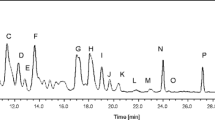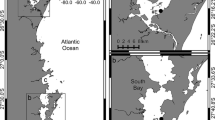Abstract
Blooms of Dinophysis in French coastal waters are implicated in most bans on marketing commercial bivalves. However, the relation between Dinophysis cell density and shellfish toxicity is not always consistent. Discrepancies may be due to the simple fact that it is nearly impossible to compare an integral over a few days (shellfish toxin content) and water samples. Furthermore, it seems that cells may have a variable specific toxicity. This work focuses on the variability in cell toxicity taking into account recent findings and using liquid chromatography coupled to mass spectrometry with an ion trap and electrospray interface. Esterified analogues of okadaic acid (DTX-4 and diol-esters) have been identified in cultures of Prorocentrum lima, another okadaic acid producer. These analogues are inactive on some protein phosphatases, contrary to okadaic acid, and seem to protect the cell from harmful effects by the toxin and to be enzymatically hydrolyzed during cell lysis. In order to document specific toxicity and to validate the presence of these analogues, D. acuminata concentrates were subjected to two separate heating and freeze/thaw procedures, respectively inhibiting or promoting hydrolysis. This paper reports on the high variability of D. acuminata specific toxicity and the presence of esters found in half of the samples only.
Similar content being viewed by others
Abbreviations
- DTX(s):
-
Dinophysistoxin(s)
- HPLC:
-
high pressure liquid chromatography
- MS:
-
mass spectrometry
- OA:
-
okadaic acid
- SPE:
-
solid phase extraction
- v/v:
-
volume/volume
References
AFNOR (1998 NF V 03-110) Procédure de validation intralaboratoire d’une méthode alternative par rapport à une méthode de référence. 1er tirage 98-12-F.
Algranti P, Guilloteau M, Histe M, Lallier M, N’Guyen-Huu JJ, Russoto R (1992) Guide de validation analytique, rapport d’une commission SFSTP-Méthodologie et exemple d’application. STP PHARMA Pratiques 2: 205–226.
Andersen P, Hald B, Emsholm H (1996) Toxicity of Dinophysis acuminata in Danish coastal waters. In Yasumoto T, Oshima Y, Fukuyo Y (eds), Harmful and Toxic Algal Blooms, IOC of UNESCO, pp. 281–283.
Bialojan C, Takai A (1988) Inhibitory effect of a marine sponge toxin, okadaic acid, on protein phosphatases. Biochem. J. 256: 283–290.
Fernandez ML, Reguera B, Ramilo I, Martinez A (2000) Toxin content of Dinophysis acuminata, D. acuta and D. caudata from the Galician Rias Bajas. In Hallegreaff GM, Blackburn SI, Bolch CJ, Lewis RJ (eds), Harmful Algal Blooms 2000. IOC of UNESCO, pp. 360–363.
Gentien P, Lunven M, Lehaître M, Duvent JL. (1995) In situ depth profiling of particles sizes. Deep-Sea Res. 42: 1297–1312.
Hoshiai G, Suzuki T, Onodera T, Yamasaki M, Taguchi S (1997) A case of non toxic mussels under the presence of high concentrations of toxic dinoflagellate Dinophysis acuminata that occured in Kesennuma Bay, Northern Japan. Fisheries Science 63: 317–318.
Hu T, Curtis JM, Walter JA, Wright JLC (1995a) Identification of DTX-4, a new water-soluble phosphatase inhibitor from the toxic dinoflagellate Prorocentrum lima. J. Chem. Soc. Chem. Commun.: 597–599.
Hu T, Curtis JM, Walter JA, McLachlan JL, Wright JLC (1995b) Two new water-soluble DSP toxin derivatives from the Dinoflagellate Prorocentrum maculosum: possible storage and excretion products. Tetrahedron Lett. 36(51): 9273–9276.
Jackson D, Silke J (1995) Dinophysis spp and the occurrence of Diarrhetic Shellfish Poisons in Ireland. In Lassus P, Arzul G, Erard E, Gentien P, Marcaillou C (eds), Harmful Marine Algal Blooms. Lavoisier Intercept Ltd, pp. 789–794.
Lee JS, Igarashi T, Fraga S, Dahl E, Hovgaard P, Yasumoto T (1989) Determination of diarrhetic shellfish toxins in various dinoflagellate species. J. Appl. Phycol. 1: 147–152.
Marcaillou Le Baut C, Gentien P, Lunven M, Le Grand J, Mondeguer F, Daniélou MM, Crassous MP, Youénou A (2001) Dinophysis acuminata distribution and specific toxin content in relation to mussel contamination. In Hallegreaff GM, Blackburn SI, Bolch CJ, Lewis RJ (eds), Harmful Algal Blooms 2000. IOC of UNESCO, pp. 356–359.
Marr JC, Jackson AE, McLachlan JL (1992) Occurrence of Prorocentrum lima, a DSP toxin-producing species from the Atlantic coast of Canada. J. appl. Phycol. 4: 17–24.
Mondeguer F, Genin E, Mestre G, Nsengiyumva C (2004) Validation of an automated procedure of solid phase extraction of mussel digestive glands for identification and quantification of dinophysistoxins in LC/ESI/MS2 by quadrupole ion trap. (Submitted to the 5th International Conference on Molluscan Shellfish Safety, Galway, Ireland, June 2004).
Moroño A, Arévalo F, Fernández ML, Maneiro J, Pazos Y, Salgado C, Blanco J (2003.) Accumulation and transformation of DSP toxins in mussels Mytilus galloprovencialis during a toxic episode caused by Dinophysis acuminata. Aquatic Toxicol. 62: 269–280.
Quilliam MA (1995) Analysis of diarrhetic shellfish poisoning toxins in shellfish tissue by liquid chromatography with fluorometric and mass spectrometric detection. J. AOAC Int. 78: 555–569.
Quilliam MA, Hardstaff WR, Ishida N, MCLachlan JL, Reeves AR, Ross NW, Windust AJ (1996) Production of diarrhetic shellfish poisoning (DSP) toxins by Prorocentrum lima in culture and development of analytical methods. In Yasumoto T, Oshima Y, Fukuyo Y (eds), Harmful and Toxic Algal Blooms, IOC of UNESCO, pp. 289–292.
Sato S, Koike K, Kodama M (1996) Seasonal variation of okadaic acid and dinophysistoxin-1 in Dinophysis spp in association with the toxicity of scallop. In Yasumoto T, Oshima Y and Fukuyo Y (eds), Harmful and Toxic Algal Blooms, IOC of UNESCO, pp. 285–288.
Suzuki T, Mitsuya T, Imai M, Yamasaki M (1997) DSP toxin contents in Dinophysis fortii and scallops collected at Mutsu bay, Japan. J. appl. Phycol. 8: 509–515.
Suzuki T, Beuzenberg V, Mackenzie L, Quilliam M (2004). Discovery of okadaic acid esters in the toxic dinoflagellate Dinophysis acuta from New Zealand using liquid chromatography/ tandem mass spectrometry. Rapid Comm.Mass Spectrom. 18: 1131–1138.
Utermöhl H (1958) Zur vendhommung der quantitativen phytoplankton. Mitt. int. Verein theor. angew. Limnol. 9: 1–38.
Vale P (2004) Differential dynamics of dinophysistoxins and pectenotoxins between blue mussel and common cockle: A phenomenon originating from the complex toxin profile of Dinophysis acuta. Toxicon 44(2): 123–134.
Author information
Authors and Affiliations
Corresponding author
Rights and permissions
About this article
Cite this article
Marcaillou, C., Mondeguer, F. & Gentien, P. Contribution to toxicity assessment of Dinophysis acuminata (Dinophyceae). J Appl Phycol 17, 155–160 (2005). https://doi.org/10.1007/s10811-005-7907-z
Received:
Revised:
Accepted:
Issue Date:
DOI: https://doi.org/10.1007/s10811-005-7907-z




